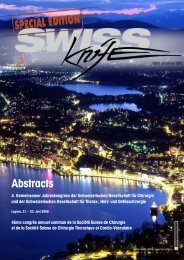Anorectal Manometry in 3D NEW! - Swiss-knife.org
Anorectal Manometry in 3D NEW! - Swiss-knife.org
Anorectal Manometry in 3D NEW! - Swiss-knife.org
Create successful ePaper yourself
Turn your PDF publications into a flip-book with our unique Google optimized e-Paper software.
length of the learn<strong>in</strong>g curve and (2) suggest suitable methods for its description.<br />
Methods: Two databases (MEDLINE, EMBASE) were used for the systematic search us<strong>in</strong>g keywords<br />
and MeSH terms. Studies were assessed for <strong>in</strong>clusion and data was extracted with respect to three<br />
categories: (1) statistical methods utilised (2) outcome parameters and (3) suggested lengths of the<br />
learn<strong>in</strong>g curve. Statistical trend analysis of the length of the learn<strong>in</strong>g curve was performed us<strong>in</strong>g mov<strong>in</strong>g<br />
average and CUSUM charts.<br />
Results: The literature search revealed 182 eligible studies, of which 27 met <strong>in</strong>clusion criteria. (1) With<br />
respect to statistical methods, 16 studies used case group<strong>in</strong>g methods, 4 used CUSUM charts and<br />
3 simple l<strong>in</strong>e graphs for cont<strong>in</strong>uous data. (2) All studies used cl<strong>in</strong>ical parameters (operat<strong>in</strong>g time,<br />
conversion rate and morbidity data). In addition, 13 studies used hospital stay, and 2 studies costs.<br />
(3) The suggested average learn<strong>in</strong>g curve was 58.4 cases with a change of trend around the year<br />
2000 (Fig. 1).<br />
Conclusion: The majority of studies used <strong>in</strong>adequate statistical methods for the description of the learn<strong>in</strong>g<br />
curve. CUSUM-type charts are <strong>in</strong>creas<strong>in</strong>gly accepted as a standard method for this purpose. All<br />
studies used cl<strong>in</strong>ical parameters as outcome measures. This is important for quality control of the<br />
learn<strong>in</strong>g process; however, its educational impact rema<strong>in</strong>s unclear. From a cl<strong>in</strong>ical viewpo<strong>in</strong>t, it is<br />
highly problematic to describe the learn<strong>in</strong>g curve us<strong>in</strong>g adverse outcome parameters. There is a statistically<br />
significant trend towards longer learn<strong>in</strong>g curves the more recent the studies were performed.<br />
This <strong>in</strong>dicates a more prudent appraisal of a complex technique with <strong>in</strong>creas<strong>in</strong>g experience.<br />
���<br />
���<br />
���<br />
���<br />
���<br />
���<br />
���<br />
��<br />
������������<br />
��������������<br />
�������������<br />
��������������<br />
�������������<br />
�����������<br />
�������������<br />
�������������<br />
not <strong>in</strong>cluded <strong>in</strong> this analysis due to lack of data)<br />
�����������<br />
�������������<br />
40.2<br />
Women <strong>in</strong> surgery <strong>in</strong> Switzerland – quo vadis?<br />
R. Kaderli, U. Güller, A. Bus<strong>in</strong>ger (Berne)<br />
36 swiss <strong>knife</strong> 2010; 7: special edition<br />
���������������<br />
������������<br />
�������������<br />
�������������<br />
������������<br />
����������<br />
����������<br />
��������������<br />
���������<br />
����������<br />
����������<br />
��������<br />
Objective: An <strong>in</strong>creas<strong>in</strong>g proportion of women is work<strong>in</strong>g <strong>in</strong> medic<strong>in</strong>e, whereas only very few choose<br />
surgical specialties. The purpose of this study is to analyze the present situation of female surgeons <strong>in</strong><br />
Switzerland and to provide a profile of their personal and professional fulfillment.<br />
Methods: An anonymous survey among board-certified female surgeons, female residents of surgical<br />
departments and female surgeons work<strong>in</strong>g <strong>in</strong> their own practice was conducted from February to April<br />
2008. The questionnaire addressed demographics, professional situation/career, family issues and<br />
work-life-balance. In all, 189/327 (57.8%) questionnaires were returned.<br />
Results: The study sample consisted of 106 (56%) surgical residents and 83 (44%) board-certified<br />
female surgeons. The median age was 33 (25-63) years. Most participants worked <strong>in</strong> a surgical field<br />
(88%), 3% were employed <strong>in</strong> a non surgical field (e.g. adm<strong>in</strong>istration, <strong>in</strong>dustry) and 9% <strong>in</strong>dicated family<br />
as field of work. A full time job was practised by 83%, 75% were married or liv<strong>in</strong>g with a partner,<br />
24% had children. In the subset of female surgeons who are mothers, 78% did rely on non-parental<br />
supervision. Of the participants without a family, 72% aimed for start<strong>in</strong>g one <strong>in</strong> the future. Assessed on<br />
a 7-po<strong>in</strong>t Likert on which “1” <strong>in</strong>dicates “very satisfied” and 7 “very unsatisfied”, the participants were<br />
satisfied both with their professional and personal life situation (2.7 (SD 1.3) vs. 3.0 (1.7); p=0.04). The<br />
most important factors to change to <strong>in</strong>crease the attractiveness <strong>in</strong> surgery were “amelioration of time<br />
pressure” (26%), “regulation of workload” (20%) and “<strong>in</strong>troduction of structured tra<strong>in</strong><strong>in</strong>g programs”<br />
(12%). Overtime work hours were reported by 75% of all female surgeons, 64% would like to work<br />
part-time. Mentor-mentee-relationships were exist<strong>in</strong>g <strong>in</strong> 58% of participants.<br />
Conclusion: There are only few women choos<strong>in</strong>g surgery as a career. However, female surgeons <strong>in</strong><br />
Switzerland are satisfied with professional and personal situation. To further improve the <strong>in</strong>dicated<br />
dis<strong>in</strong>centive work-life and family-life factors, more part time jobs and more frequent mentor-mentee<br />
relationships should be sought.<br />
40.3<br />
From coal m<strong>in</strong>es to diamond fields? Assessment of job satisfaction <strong>in</strong> surgical residency and its implications<br />
M. von Websky 1 , C. Oberkofler 1 , K. Rufibach 1 , D. Raptis 1 , K. Lehmann 1 , G. Lurje 1 , E. Fitzgerald 2 , D. Hahnloser<br />
1 , P.-A. Clavien 1 ( 1 Zurich, 2 London/UK)<br />
Objective: To assess job satisfaction <strong>in</strong> surgical residency with a validated <strong>in</strong>strument and identify factors<br />
associated with it.<br />
Methods: A survey among 2050 surgical residents was conducted <strong>in</strong> 3 European countries assess<strong>in</strong>g<br />
job satisfaction with the validated Global Job Satisfaction Instrument (GJS). We related 22 questions<br />
cover<strong>in</strong>g different aspects of surgical residency with the response to GJS (satisfaction yes/no) us<strong>in</strong>g<br />
logistic regression analysis.<br />
Results: Response rate among the 3 countries varied (Germany 20%, Switzerland 30%, UK 10%). 71%<br />
of residents were satisfied and 29% were dissatisfied with their job (95% CI: [24%, 34%]). Satisfaction<br />
was associated with good work<strong>in</strong>g climate among residents (OR 3.71; p
















